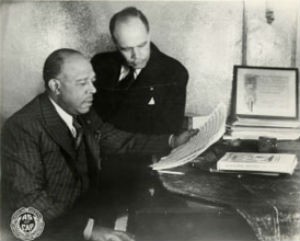James Weldon Johnson is often called the Renaissance Man of the Harlem Renaissance—with good reason. The author of the novel The Autobiography of An Ex-Colored Man, he was also a respected poet, newspaper columnist, diplomat and the first black leader of the NAACP. But he is perhaps best known for writing the lyrics to the stirring “Lift Every Voice and Sing” with his talented younger brother, composer, arranger, actor and music school founder J. Rosamond Johnson, back in 1900.
The Autobiography of an Ex-Colored Man is available in other formats.
As Weldon Johnson recounts in his autobiography, Along This Way, while he was a school principal in his native Florida, he and his brother wrote the song for his 500 students to sing on President Lincoln's birthday. But in the years after that performance, the song took on a life of its own.
“[T]he schoolchildren of Jacksonville kept singing the song," he writes in Along This Way. "Some of them went off to other schools and kept singing it; some of them became schoolteachers and taught it to their pupils. Within 20 years the song was being sung in schools and churches and on special occasions throughout the South," much to the surprise and pleasure of its creators.
Its adoption as the official song of the NAACP furthered its popularity, and today it is commonly referred to as the Black National Anthem. With J. Rosamond Johnson's rolling, haunting 6/8 melody and his brother's poetic and powerful lyrics, it's a deeply moving song that addresses our nation's dark past, but also inspires hope and courage: "Facing the rising sun of our new day begun/Let us march on till victory is won."
It's a song that has touched many, as recounted in Lift Every Voice and Sing: A Celebration of the Negro National Anthem, published on the centenary of its composition. This beautiful book features 100 essays by artists, politicians, educators and more on the song and what it means to them, as well as 100 photographs documenting African American history from 1900 to 2000. As Evanston native and award-winning author Charles Johnson writes, the "elder Johnson gave Americans, black and white, that rarest of literary gifts—a song worthy of singing for a century."
Renditions of the song range from the relatively traditional one above to the soaring R&B interpretation below, the latter performed by the amazing Merry Clayton (of 20 Feet from Stardom fame). Clayton's performance is also on The Best of Merry Clayton, one of several CDs featuring the song.
Want to share this wonderful song with a young person? Check out the picture book Lift Every Voice and Sing, in which the lyrics are accompanied by the vibrant illustrations of Caldecott honoree Bryan Collier. You can even sing it together—the melody is in back!
How old were you when you first heard "Lift Every Voice and Sing" and where did you hear it? (I learned it in third grade, thanks to my teacher Mr. Oliver Ruff.)




Add a comment to: The Black National Anthem and the Multitalented Men Who Wrote It